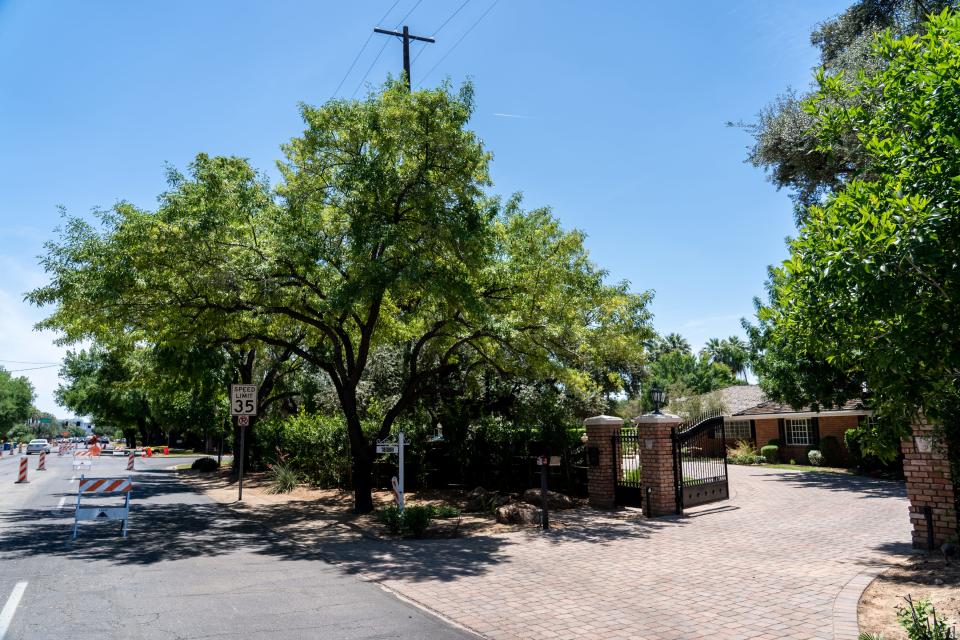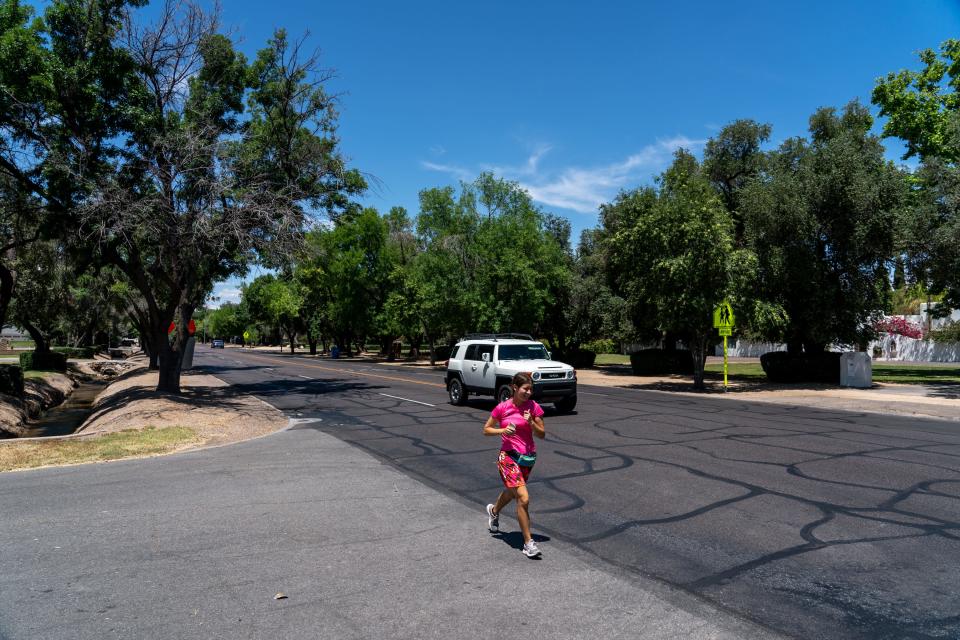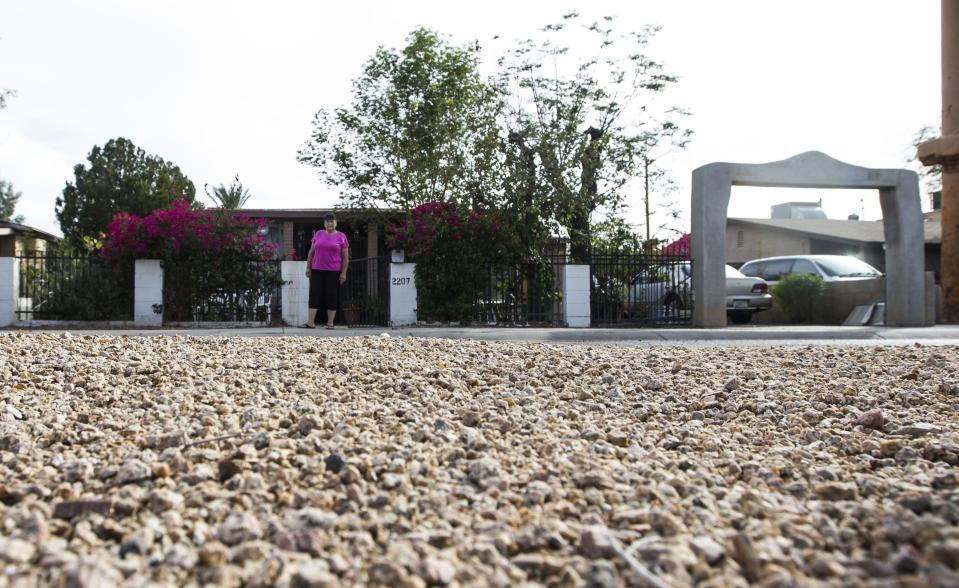Phoenix wanted more shade trees by 2030, but is falling far short of goals. Here's why
In 2010, Phoenix City Council approved an ambitious goal to plant enough trees to shade 25% of the city by 2030. Thirteen years later, city officials don't know how much progress they've made, if any.
Recent 2020 data from American Forests, a national nonprofit, says Phoenix's tree shade canopy is at 10%. City officials in 2010 said it fell between 11% and 13%.
Phoenix Heat Director Dave Hondula says those statistics lack nuance, and the method used to reach them may not be the right formula for the city. The 2010 plan didn't specify how it measures shade canopy, which makes tracking progress challenging.
As city officials look ahead to the 2030 deadline, there is little hope Phoenix will accomplish the 25% goal. A lack of citywide metrics, economic turmoil, confusion over the goals, a culture of turnover and the shifting of responsibilities between myriad city departments has stunted progress.
City officials don't know how many trees they manage. The last inventory was in 2014, Hondula said. They also don't know how many total trees they've planted. Spokespeople for the city said individual departments had counts from specific projects but no cumulative total.
The 2010 Tree and Shade Masterplan included a three-page "Action Item Checklist" with 63 tasks. Approximately 40% of the tasks have been completed, according to a review by Hondula, Phoenix tree manager Lora Martens, and environmental programs administrator Nancy Allen. A little more than half the tasks were not done, partially done, or the status was unknown. The rest are in progress.
Broad consensus exists inside City Hall that the plan fizzled out somewhere along the way, and that a goal to target plantings where trees are most needed should replace the overall 25% target. There is less agreement about how and why the 2010 plan stalled.

The Arizona Republic spoke with two former mayors, two former city managers, a former deputy city manager and a former planning director to understand the plan's trajectory. Some thought lack of funding, staff turnover and unclear implementation plans probably contributed.
Community advocates on a city subcommittee to advance Phoenix's tree goals shared experiences of feeling de-prioritized. They viewed the city as unenthusiastic and said the City Council lacked the vision and political will to make it happen.
"It is incredibly frustrating ... and it has burned me out of local politics," said tree advocate Tabitha Myers.
Current City Hall insiders hope the next decade will be different.
Mayor Kate Gallego points to unprecedented funding for tree shade in Phoenix:
City Council allocated $4 million in federal funding for tree planting initiatives in schools and low-income neighborhoods in 2022.
The U.S. Forest Service awarded Phoenix a $10 million grant for tree shade in September.
Gallego also said the city's heat office now employs six staff members who work on tree shade, and multiple departments employ certified arborists.
"When you have positions that are permanently dedicated to areas, you get more results," the mayor said. She added, "I'm also proud to have been named a tree equity champion by American Forests in 2022."
Hondula and Martens said they are working on "updating" the Tree and Shade Masterplan and plan to present suggestions to City Council next spring.
They want to replace the 25% goal with specific shade canopy targets for different areas, including much higher percentages for pedestrian areas.

While details remain unclear, Hondula said he is confident any trees planted in the meantime will help.
"It's hard to take a misstep with tree planting efforts in Phoenix," Hondula said.
Martens added, "There is going to be a high-fiving moment. Hopefully many high-fiving moments along the way."
The heat office wants a future shady enough for Phoenix pedestrians to safely walk 20 minutes in the summer.
But for advocates like Myers and Nicole Rodriguez, who spent years pushing the city for more tree shade, they'll believe it when they see it.
"Hopefully I'm proven wrong," Myers said. "(But) what accountability is there going to be moving forward?"
What happened after the 2010 plan passed?
The 2010 Tree and Shade Masterplan plan aimed to increase Phoenix's shade canopy to 25% by 2030, but that wasn't the only goal. The plan's 3-page checklist focused on education and awareness, preserving and increasing the number of trees, and changing city rules to encourage sustainable infrastructure.
The plan was supposed to be updated every two years "to ensure action items are being completed."
It never was. Why is uncertain.
"It sounds very similar to me to other aspects of the heat mitigation and response world," Hondula said. "In the absence of clarity on who should be driving these efforts forward, there are missed opportunities."

Neither the mayor at the time, Phil Gordon, nor the former city manager, David Cavazos, who birthed the tree plan remembered much about the rollout.
Former Deputy City Manager Rick Naimark told The Republic he remembered "a lot of action at the beginning." The city focus was on creating the inventory, thinking about the right kinds of trees in the right places and pursuing new city requirements.
Documents on Phoenix's tree website say in 2011 five employees received arborist certifications and shade goals were incorporated into the city's strategic plan and green construction code.
"But there were also challenges that cropped up," Naimark said. Figuring out how to keep property owners from removing trees was a challenge, he said. So was appropriately maintaining trees in the rights-of-way.
Naimark and multiple former city officials said sharp budget cuts from the Great Recession impeded the tree program.
Debra Stark, who is now an elected City Council member but was the planning director in 2010, said at some point, more tree responsibilities shifted from the parks department to the streets department.
Stark thinks that may have caused confusion about which departments led various tree goals.
Greg Stanton inherited the plan when he became mayor in 2012. He said he was kept apprised of tree-planting efforts, but they took a backseat to the city's more pressing economic issues. The Great Recession had caused a hiring freeze, and Stanton said his focus was squarely on keeping the lights on at City Hall.
"We had to be very tight with our budget," Stanton said.
A review of Phoenix infrastructure budgets since 2010 shows the city planned to invest $152,000 in tree planting in 2010 and $250,000 in 2011. Those investments stopped between 2012 and 2017 before picking back up in 2018.
In 2021, the City Council's Climate Action Plan briefly touched on the Urban Forest Implementation Team, an internal city team established in the 2010 plan. It was supposed to coordinate citywide tree efforts and monitor progress.
The Republic sought to reach out to members of the urban forestry team, but city spokesperson Keyera Williams said it hadn't met in over a year.
Allen, a program administrator at the city who was part of that team between 2018 and 2021, said she wasn't sure why.
They used to meet quarterly, and from what she remembers, a recurring topic of discussion was how to find more funding for a tree inventory, maintenance and replacement.
"There was no way to track all those trees that were lost" in storms, she said, which limited progress.
A push for progress in 2018
In April 2018, a group of Phoenix residents banded together to petition the city to make progress on the 2010 tree plan.
They called themselves the ad-hoc Citizen Tree and Shade Committee and consisted of two attorneys, a licensed arborist, a small business owner, three landscape architects, an economic development professional, two city staffers, an architect and a former councilman.
Their petition called on the Phoenix City Council to create a Citizen Tree and Shade Committee as outlined in the 2010 plan.
The council agreed to form it under the existing Environmental Quality and Sustainability Commission.
Nicole Rodriguez, an arborist on the subcommittee, saw it as "window dressing."
Ad hoc members had wanted to be a standalone committee. They viewed it as the more effective way to get policy recommendations considered and adopted by the City Council. Being under the Sustainability Commission meant one extra hurdle to clear.
Still, the subcommittee made meaningful advancements.
Phoenix started investing in trees again, allocating approximately $400,000 annually for tree replacement starting in 2018. In 2019, the city planted more than 4,000 trees, more than any year in the previous decade, according to the 2020 budget.
The subcommittee also recommended the heat office that was formed in 2021, plus the tree manager position that Martens now holds. Their "advocacy resulted in over $2 million in heat readiness investments," according to Phoenix's website.
Then, the subcommittee was forced to disband in December 2022, despite substantial unfinished work, Rodriguez said.
They wanted to continue recommending policies, such as what levels of shade canopy should be required for different areas, Rodriguez said.
Mayor Gallego said the heat office has adopted the work and is ready to do extensive public outreach now to answer those questions.
Six years to go, and the pathway is uncertain
Hondula said his office hasn't let ambiguities or unresolved questions about the 2010 plan hold the city back.
Recent budget decisions indicate the city is taking tree shade more seriously than ever before.
In 2023, Phoenix's investment in tree shade soared. The city maintained the $400,000 investment in tree replacement, plus added $1.46 million annually for tree planting over the next five years. The City Council approved a budget that included funding for five new staffers to expand tree planting.
Outside organizations have noticed Phoenix's recent work. The Arbor Day Foundation recognized Phoenix as a "Tree City of the World," for the past two years. The award is for cities committed to maintaining urban forests.
At the same time, Hondula said he knows tree shade needs to improve and that his office feels the pressure to deliver updated goals to City Council this spring.
For any new goals to be met, Hondula and Martens said, it comes down to four key areas:
Resources for tree planting, especially on private property, which the city doesn't control.
Strengthening the urban forestry workforce. It will be hard to make progress if employees who maintain trees and irrigation systems don't exist, Martens said.
Improving city policies and the processes related to tree protections. Martens said the city's working to streamline the system for addressing tree concerns. Improving interactions with Spanish-speaking residents is also critical, she said.
Improving data monitoring technology, such as the tree inventory but also tracking irrigation. Hondula said that could help the city react quicker to watering problems and avoid situations where trees go without water in the summer.
Stark, in reflecting on the 2010 plan, said, ensuring proper funding to implement goals was critical.
She added that the city will plant a ton of trees in one area, then move on to the next project, "and if a tree dies and they're not alerted to it, that's part of the problem in managing it. ... It would be kind of nice to have an inventory."
The federal grants Phoenix has received for tree planting efforts come with strings attached, such as providing shade at schools or in low-income areas.
The grants also include accountability reporting requirements, which the mayor said she advocated for.
"I think that shows that we're putting real emphasis on tree planting and changing the investments in trees," Gallego said.
But advocates like Rodriguez and Myers want more results and less talk.
Myers wants the city to clarify how it's going to move forward. She hopes the Council implements stronger tree protections, including repercussions for developers who cut down or fail to maintain their trees.
Rodriguez hopes the city works to cut red tape and becomes more willing to listen to the community.
"My experience with park leadership is they're empty shirts. It's just a day job for them," Rodriguez said.
The mayor refuted claims the city lacked passion for tree shade.
"They are excellent professionals who could make more money working elsewhere, and they've decided that they want to be part of the solution here in Phoenix. I'm very proud of our staff," Gallego said.
Reporter Taylor Seely covers Phoenix for The Arizona Republic / azcentral.com. Reach her at tseely@arizonarepublic.com or by phone at 480-476-6116.
Reporting from Alexis Egeland, who formerly worked at The Republic, was included in this report.
This article originally appeared on Arizona Republic: Phoenix won't reach its tree shade goals, so its going to change them

